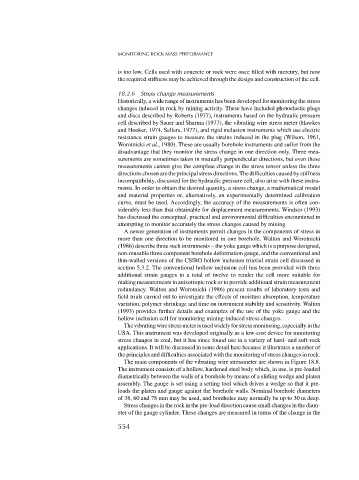Page 572 - Rock Mechanics For Underground Mining
P. 572
MONITORING ROCK MASS PERFORMANCE
is too low. Cells used with concrete or rock were once filled with mercury, but now
the required stiffness may be achieved through the design and construction of the cell.
18.2.6 Stress change measurements
Historically, a wide range of instruments has been developed for monitoring the stress
changes induced in rock by mining activity. These have included photoelastic plugs
and discs described by Roberts (1977), instruments based on the hydraulic pressure
cell described by Sauer and Sharma (1977), the vibrating wire stress meter (Hawkes
and Hooker, 1974, Sellers, 1977), and rigid inclusion instruments which use electric
resistance strain gauges to measure the strains induced in the plug (Wilson, 1961,
Worotnicki et al., 1980). These are usually borehole instruments and suffer from the
disadvantage that they monitor the stress change in one direction only. Three mea-
surements are sometimes taken in mutually perpendicular directions, but even these
measurements cannot give the complete change in the stress tensor unless the three
directionschosenaretheprincipalstressdirections.Thedifficultiescausedbystiffness
incompatibility, discussed for the hydraulic pressure cell, also arise with these instru-
ments. In order to obtain the desired quantity, a stress change, a mathematical model
and material properties or, alternatively, an experimentally determined calibration
curve, must be used. Accordingly, the accuracy of the measurements is often con-
siderably less than that obtainable for displacement measurements. Windsor (1993)
has discussed the conceptual, practical and environmental difficulties encountered in
attempting to monitor accurately the stress changes caused by mining.
A newer generation of instruments permit changes in the components of stress in
more than one direction to be monitored in one borehole. Walton and Worotnicki
(1986) describe three such instruments – the yoke gauge which is a purpose designed,
non-reusable three component borehole deformation gauge, and the conventional and
thin-walled versions of the CSIRO hollow inclusion triaxial strain cell discussed in
section 5.3.2. The conventional hollow inclusion cell has been provided with three
additional strain gauges to a total of twelve to render the cell more suitable for
making measurements in anisotropic rock or to provide additional strain measurement
redundancy. Walton and Worotnicki (1986) present results of laboratory tests and
field trials carried out to investigate the effects of moisture absorption, temperature
variation, polymer shrinkage and time on instrument stability and sensitivity. Walton
(1993) provides further details and examples of the use of the yoke gauge and the
hollow inclusion cell for monitoring mining-induced stress changes.
Thevibratingwirestressmeterisusedwidelyforstressmonitoring,especiallyinthe
USA. This instrument was developed originally as a low-cost device for monitoring
stress changes in coal, but it has since found use in a variety of hard- and soft-rock
applications. It will be discussed in some detail here because it illustrates a number of
the principles and difficulties associated with the monitoring of stress changes in rock.
The main components of the vibrating wire stressmeter are shown in Figure 18.8.
The instrument consists of a hollow, hardened steel body which, in use, is pre-loaded
diametrically between the walls of a borehole by means of a sliding wedge and platen
assembly. The gauge is set using a setting tool which drives a wedge so that it pre-
loads the platen and gauge against the borehole walls. Nominal borehole diameters
of 38, 60 and 78 mm may be used, and boreholes may normally be up to 30 m deep.
Stress changes in the rock in the pre-load direction cause small changes in the diam-
eter of the gauge cylinder. These changes are measured in terms of the change in the
554

